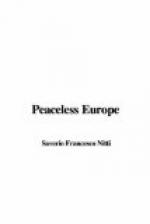Peoples, like individuals, are far from representing with anything approaching completeness such social conceptions as we call violence and right, honesty and bad faith, justice and injustice; each people has its different characteristics, but no one people represents good, or another bad, no one represents brutality, or another civilization. All these meaningless phrases were brought out during the War, according to which, as was said by one of the Prime Ministers of the Entente, the War was the decisive struggle between the forces of autocracy and liberty, between the dark powers of evil and violence and the radiant powers of good and right. To-day all this causes nothing but a smile. Such things are just speechifying, and banal at that. Perhaps they were a necessity of War-time which might well be made use of; when you are fighting for your very life you use every means you have; when you are in imminent danger you do not choose your weapons, you use everything to hand. All the War propaganda against the German Empires, recounting, sometimes exaggerating, all the crimes of the enemy, claiming that all the guilt was on the side of Germany, describing German atrocities as a habit, almost a characteristic of the German people, deriding German culture as a species of liquid in which were bred the microbes of moral madness—all this was legitimate, perhaps necessary, during the War. The reply to the asphyxiating gas of the enemy was not only the same gas, but a propaganda calculated to do more damage, and which, in fact, did do as much damage as tanks and blockade.
But, when war is over, nothing should be put into a peace treaty except such things as will lead to a lasting peace, or the most lasting peace compatible with our degree of civilization.
On January 22, 1917, President Wilson explained the reasons why he made the proposal to put an end to the War; he said in the American Senate that the greatest danger lay in a peace imposed by conquerors after victory. At that time it was said that there must be neither conquerors nor conquered. A peace imposed after victory would be the cause of so much humiliation and such intolerable sacrifices for the conquered side, it would be so severe, it would give rise to so much bitter feeling that it would not be a lasting peace, but one founded on shifting sand.
In the spring of 1919, just before the most serious decisions were to be taken, Lloyd George put before the conference a memorandum entitled “Some considerations for the Peace Conference before they finally draft their terms.”
With his marvellously quick insight, after having listened to the speeches of which force was the leading motive (the tendency round him was not to establish a lasting peace but to vivisect Germany), Lloyd George saw that it was not a true peace that was being prepared.
On March 25, 1919, Lloyd George presented the following memorandum to the conference:




